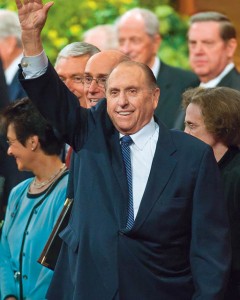Thomas S. Monson, prophet of the Church of Jesus Christ of Latter-day Saints, whose members are sometimes called Mormons, was called to be a bishop when he was just twenty-two years old. A bishop is similar to a pastor, but he runs his ward (congregation) as a lay minister, and so must also manage a career and a family at the same time. LDS wards are very demanding and the service requirements are great. Most bishops are far older and have far more experience, and young Bishop Monson had an additional challenge. In a large congregation of over 1,050 members, 87 were widows. Wards are made up of all members in an assigned geographical area, and his was one of great need. They had of the largest welfare load in the church. This does not refer to government welfare, but to church welfare. The church does as much for its own as possible and Thomas Monson had the largest number of people in need of any congregation in the entire church.
 He wrote of his ward, “The street addresses in that ward did not read like some: Colonial Hills Circle, Mountain View Estates, or Skyline Drive. Rather, they were noted as Orchard Place, Gale Street, Elford Court. The ward was not east of the tracks in Salt Lake City. It was not west of the tracks. That ward spanned the railroad tracks. Many of the widows and those in financial need were hidden away in basement apartments, upstairs back rooms, or dilapidated houses situated at the rear of little-known streets. I became the shepherd. This was my flock. I was reminded of God’s warning through Ezekiel: “Woe be to the shepherds of Israel that feed not my flock” (see Ezek. 34:2-3).”
He wrote of his ward, “The street addresses in that ward did not read like some: Colonial Hills Circle, Mountain View Estates, or Skyline Drive. Rather, they were noted as Orchard Place, Gale Street, Elford Court. The ward was not east of the tracks in Salt Lake City. It was not west of the tracks. That ward spanned the railroad tracks. Many of the widows and those in financial need were hidden away in basement apartments, upstairs back rooms, or dilapidated houses situated at the rear of little-known streets. I became the shepherd. This was my flock. I was reminded of God’s warning through Ezekiel: “Woe be to the shepherds of Israel that feed not my flock” (see Ezek. 34:2-3).”
The young bishop worked very hard to care for the many widows who were under his stewardship. He visited every single one of them at Christmas time, using a full week of his personal vacation to do so.
There is more to this story, however. He continued those Christmas visits every year, even after he was no longer their bishop, and even after he was made a General Authority, one of the highest church positions with international responsibility. He always brought them a gift. In the early days, this was often a dressed hen from his own flock. He met other widows at the nursing homes where some of these women eventually moved to, and added visits to those women as well. And, despite extensive travel for church responsibilities, he spoke at the funerals of every one of those original widows. To this day, he makes regular visits to widows he has met in the course of his great service to the people of the church.
Of one such visit he wrote: “There is a much larger home here where many widows reside. Most are seated in the well-lighted living room. But in her bedroom, alone, is one on whom I must call. She hasn’t spoken a word since a devastating stroke some years ago. But then, who knows what she hears, so I speak of good times together. There isn’t a flicker of recognition, not a word spoken. In fact, an attendant asks if I am aware that this patient hasn’t uttered a word for years. It makes no difference. Not only have I enjoyed my one-sided conversation with her-I have communed with God.” (Thomas S. Monson, “The Long Line of the Lonely,” Ensign, Feb 1992, 2)
President Thomas S. Monson is a powerful example of compassionate, Christ-like giving for the members of the church.
Twitter •

It’s sad when great men and great stories are embellished to the point of mythology. It would have been impossible for him to visit EVERY widow EVERY year. He was gone to Toronto Canada as a mission President for 3 years and clearly wasn’t able to speak at the funerals of those who died during those years.
I am so touched of the story. He is indeed a man of God.